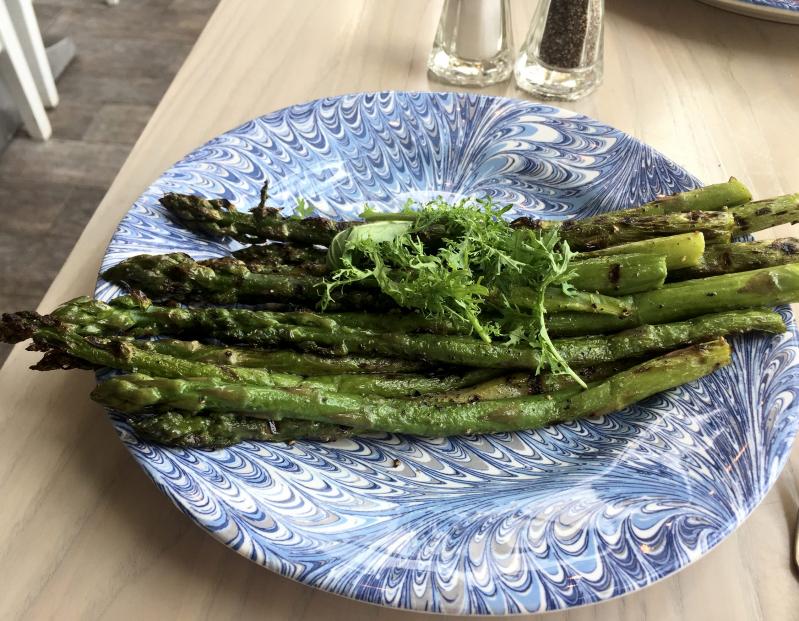Have you ever tasted freshly picked asparagus? I mean, picked within hours of being hand harvested? It is remarkably sweet. Asparagus is similar to corn in that, once picked, it will use its sugars to survive. Corn converts sugar into starch, asparagus uses its sugar to make tough lignified fibers, similar to bean pods and broccoli.
Some of the best asparagus I have ever tasted was purchased at the East Hampton farmers market a few weeks ago. It was purple and of moderate thickness. I roasted it and it remained purple, crisp, and sweet. When I opened the fridge the next morning to use the leftover stalks in an omelet, they had turned green.
Asparagus has been grown and eaten for over 2,000 years and has been considered medicinal and aphrodisiacal. For hundreds of years it was classified as a member of the lily family, now it is in a class of its own. Also, F.Y.I., it is not referred to as “asparagi” in the plural unless you are speaking Latin. Showoff.

The beauty of asparagus is its versatility in cooking. You can eat it raw, shaved into a salad with a lemony dressing, shaved Parmesan, and pine nuts. One asparagus salad recipe had fried pastrami bits on top. It can be steamed, grilled, roasted, and pickled.
Grilling is a great method to cook it if you care about wine pairings. The char and smoky flavor make it more compatible with a pinot blanc or pinot grigio. A creamy sauce like Hollandaise can also encourage it to play nice with others. My solution? Champagne. Because asparagus means spring and this also means rhubarb, which then leads to strawberries, and then we are in the full glory of bountiful produce. And that calls for a celebration.
Steaming is a good method, especially if you can keep the asparagus upright, thus cooking the tips less, the stalks more. To grill, you can either use a vegetable grilling grate or skewer the asparagus in rows, like a raft, with pre-soaked wooden skewers. Use two to three skewers for each raft so they don’t flop and spin around. For roasting, a toss with olive oil and salt and pepper will do; then cook at 450 degrees for 5 to 10 minutes. From there I add lemon juice or Parmesan cheese. I always buy an extra pound of asparagus so there will be some extra for pasta primavera or a risotto or frittata.
When preparing asparagus before cooking, remember to rinse well, or soak in cold water briefly, especially if it’s local. It may have a good bit of grit stuck inside the little bracts at the top of the spear. Always cut off the woody ends. To determine where the tender part and tough parts are, simply find the place where they are easy to snap. With larger asparagus, you can peel the bottom half or third of each stalk. If you are dealing with white asparagus, you must always peel every stalk.
If you have purchased your asparagus at the supermarket, chances are good that it had a long, slow, arduous journey from Peru so check the tops to make sure they are firm and tight, with no mushy spots. It’s a bonus if your market has the good sense to store them upright in about one inch of water. This is also a good method for home storage. Just place them in your refrigerator in a big glass or jar with a little water on the bottom and loosely cover the top. Definitely eat them within a day or two of purchase.
The savvy and frugal cook knows that the stems are worth saving to make soup. When is the last time you had a silky smooth cream of asparagus soup topped with dainty, blanched tips?
Asparagus is a very healthful vegetable. It is a natural diuretic, has vitamins K, C, B9 (folate), and E. It has anti-inflammatory and antioxidant nutrients, betacarotene, and the minerals zinc, manganese, and selenium. But what about that odor emitted from our urine shortly after consuming asparagus? This is from asparagusic acid, which breaks down in our bodies into sulfurous compounds similar to garlic, skunk spray, and odorized natural gas. It has been concluded, after way too much study, that every body produces this compound after eating asparagus but not everyone can smell it.
Benjamin Franklin was so concerned over this unpleasant phenomenon that he wrote to the Royal Academy in Brussels in 1781, imploring them to “discover some drug” that would get rid of this “disagreeable Odour.” According to Smithsonian magazine he also asked the academy to figure out how to “render the natural Discharges of Wind from our Bodies, not only inoffensive, but as agreeable as perfumes.” (His caps, not mine.) But that’s a story for an article on beans, don’t you think?
The season for asparagus won’t last much longer out here, so consider some of these cooking methods that you haven’t tried before. Or do as the northern Europeans do to celebrate the first harbingers of spring, build a whole meal around asparagus. Serve one pound per person with parsleyed new potatoes, some rich Hollandaise sauce on the side (or simply lemon butter), and a few shavings of paper-thin cured ham. Tis the season for spargelspitzen!

